7 Best High-Protein Burger King Orders, According to a Dietitian
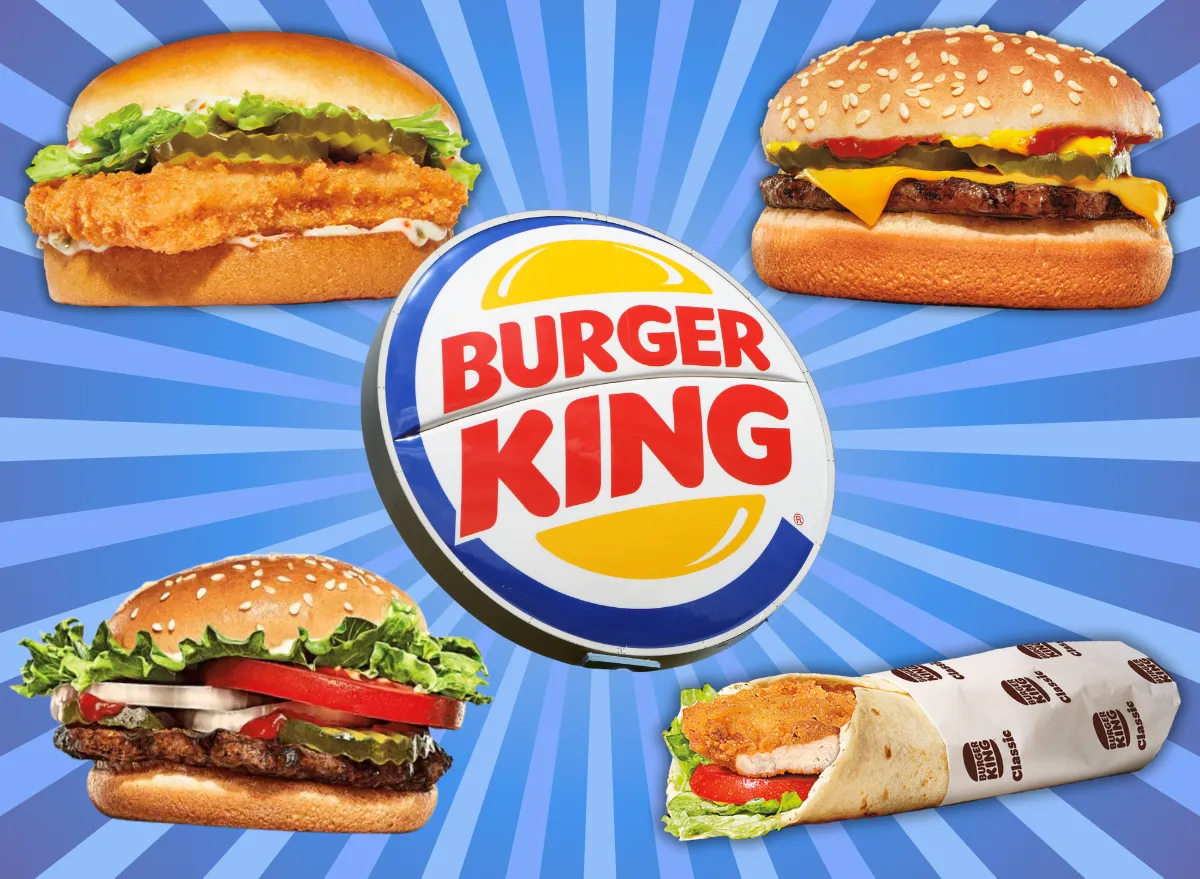
Home of the Whopper, Burger King has become a global fast food chain synonymous with large, flavorful burgers. And, despite the heavily marketed burgers with bacon, cheese, and a patty (or three) of meat, there are a few protein-packed options on the menu that won't leave you feeling sluggish with that Thanksgiving-full feeling.
Protein is one of the three macronutrients essential for keeping you full and supporting muscle maintenance and growth. The general recommendation for protein is 46-56 grams per day for adults, though many dietitians (myself included) suggest aiming for 1 to 1.4 grams per kilogram of body weight. For example, if you weigh 150 pounds, you should target 68-95 grams of protein daily. While protein may help with appetite control and food cravings, it's not the only macronutrient to focus on. Carbohydrates, like dietary fiber, and healthy fats, like those found in avocado and nuts, are necessary additions to a balanced diet, too.
Unfortunately, unlike some of the other fast-casual chains, Burger King has yet to add a salad to its lineup, meaning the fiber and healthy fat content of its higher protein options need some powerful pairings to reap the benefits of these other nutrients. But don't fret! As a registered dietitian, I'm sharing how to order healthy high-protein orders, my top seven high-protein menu choices, and how to incorporate them in a balanced meal plan.
Tips for Ordering Healthy High-Protein Options at Burger King:
- Aim for a high-quality source of protein at each meal. Aim for around 20 grams or protein per meal, supplementing with protein-rich snacks to meet your needs. When your meal isn't quite this high in protein, focus on pairing other protein items with it to meet your needs.
- Focus on fiber. Fiber helps you stay fuller for longer, reducing the urge to snack between meals. Burger King's menu has limited high-fiber options, so it's important to include fiber-rich snacks like dried fruits, pears, or nuts throughout your day.
- Limit saturated fat intake to no more than 10 grams per order. The 2020-2025 Dietary Guidelines for Americans recommend limiting saturated fat intake to less than 10% of your daily calories, which is about 22 grams for a 2,000-calorie diet. Try to stay under 8–9 grams of saturated fat per Burger King order so you can balance your intake throughout the day. Consider skipping cheese on sandwiches to reduce saturated fat.
- Slash the salt. The guidelines also recommend limiting sodium to 2,300 milligrams per day (about 1 teaspoon). Many Burger King items are high in sodium, so plan your other meals and snacks accordingly if you dine out.
- Decrease added sugars. The American Heart Association recommends limiting added sugars to 6% of daily calories—around 6 teaspoons (100 calories) for women and 9 teaspoons (150 calories) for men. While the sugar content in Burger King's options is moderate for fast food, sauces can quickly increase your sugar intake. Enjoy your protein pick as listed below, or opt for plain mustard to keep the sugar in check.
Whopper Jr. (15 grams)
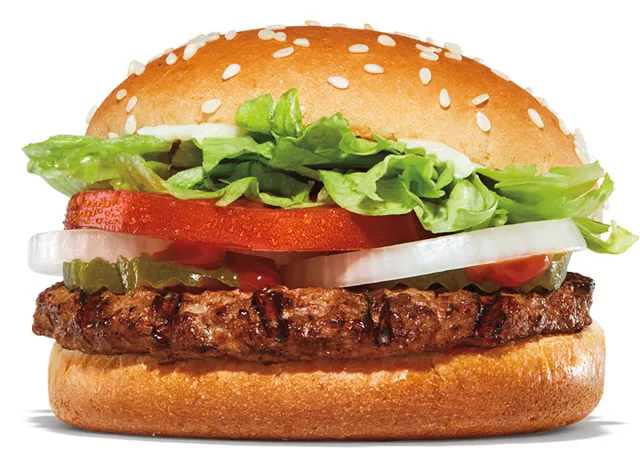
Calories: 300
Fat: 19 g (Saturated fat: 5 g)
Sodium: 560 mg
Carbs: 30 g (Fiber: 2 g, Sugar: 7 g)
Protein: 15 g
While the chain may be known for its Whopper, its Junior version is pretty stellar, nutritionally speaking. With 15 grams of high-quality protein and just 5 grams of saturated fat, this sandwich can certainly fit within a balanced meal plan. For instance, while the senior Whopper may deliver 31.5 grams of quality protein, with that protein increase also comes an additional 7 grams of saturated fat and 610 milligrams of sodium, making the added protein content a moot point when you consider the other nutrients increased here that one should be monitoring. If you're yearning for more protein, consider adding a 4-piece chicken nugget instead of the fries, which delivers 9 additional grams of protein, 2.5 grams of saturated fat, and 490 milligrams of sodium.
Cheeseburger (15 grams)
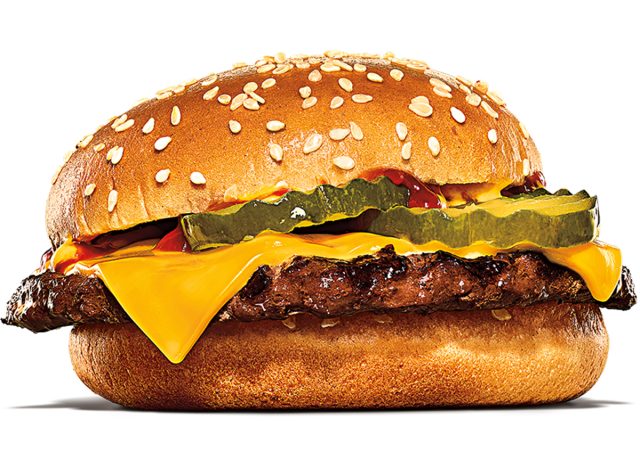
Calories: 290
Fat: 13 g (Saturated fat: 6 g)
Sodium: 780 mg
Carbs: 31 g (Fiber: 1 g, Sugar: 7 g)
Protein: 15 g
Cheese fans, this one's for you. A basic cheeseburger is actually a welcomed order at Burger King, providing 15 grams of high-quality protein for just 290 calories and 6 grams of saturated fat. While the cheese does increase the saturated fat and sodium of the burger, it still can fit into a balanced meal plan. In this case, I'd recommend that those looking for a bit more protein bang per meal opt for non-fat milk to pair with their burger. This delivers 9 grams of high-quality protein, no saturated fat, and only 125 milligrams of sodium.
Royal Crispy Wrap (15 grams)
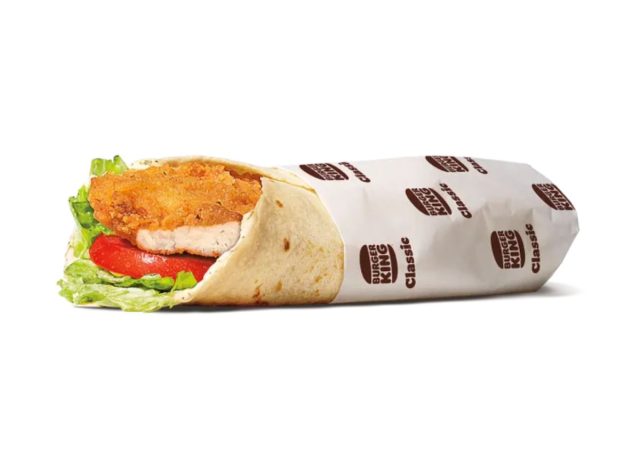
Calories: 310
Fat: 17 g (Saturated fat: 3 g)
Sodium: 790 mg
Carbs: 28 g (Fiber: 4 g, Sugar: 2 g)
Protein: 15 g
Fifteen may seem like the magic protein number here with the BK orders so far, but this handheld is one of the lower saturated fat choices that packs a good source of fiber thanks to the addition of the lettuce, tomato, and tortilla wrap. The combination of the 4 grams of filling fiber and 15 grams of protein is likely to help tie you over until your next meal. If you need an extra snack to nosh on with this wrap, opting for the Value Onion Rings can fit into a balanced diet (when consumed on occasion.) This pick has an additional 3 grams of fiber and protein with only 1.5 grams of saturated fat and just 200 calories (rounding out your meal to 510 total calories, completely reasonable for a lunch). However, the sodium will add 370 milligrams to the 790 in the wrap, meaning you will need to choose lower sodium options throughout the remainder of your day.
12-Piece Chicken Fries (20 grams)
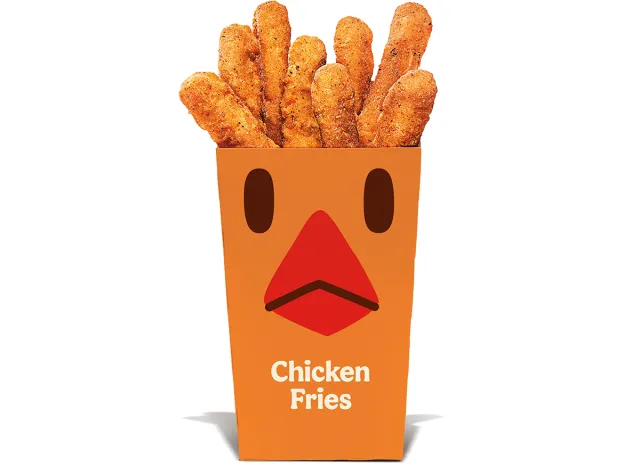
Calories: 340
Fat: 18 g (Saturated fat: 4 g)
Sodium: 1030 mg
Carbs: 25 g (Fiber: 1 g, Sugar: 0 g)
Protein: 20 g
For those who like fries and a powerful protein punch, the 12-piece Chicken Fries deliver 20 grams of protein per serving. While the saturated fat of this entree is fairly reasonable, with just 4 grams total, the sodium exceeds 1,000 milligrams. That means that when noshing on this option, you will want to make more mindful choices for the rest of the day. And, while I wish I could say toss these on top of the side garden salad for a little variety and fiber in your diet, Burger King has yet to add that option to their menu. So, when possible, consider adding these to your own salad to reap the protein punch with a side of fiber these need.
Original Chicken Sandwich (23 grams)
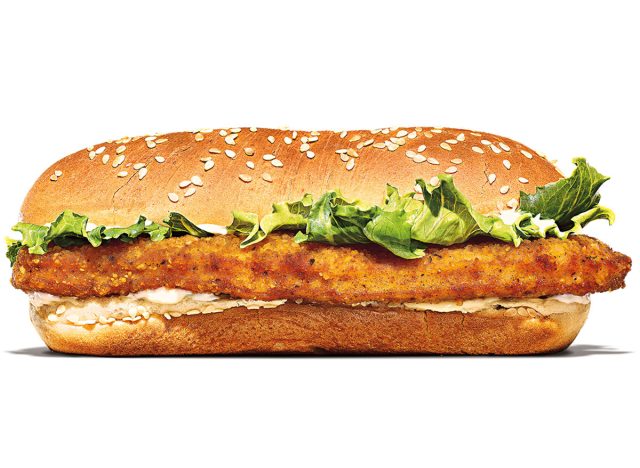
Calories: 680
Fat: 39 g (Saturated fat: 7 g)
Sodium: 1380 mg
Carbs: 63 g (Fiber: 3 g, Sugar: 8 g)
Protein: 23 g
The chicken entrees at Burger King are some of their more powerful protein picks, including the Original Chicken Sandwich. With 23 grams of high-quality protein, this crispy handheld can fit into a balanced eating plan when you're in a bind and craving crunch. While the fiber is better than some of their other options, providing 3 grams, the sodium content is also higher. You can ask for the mayonnaise to be removed, which will save you about 90 milligrams, but unfortunately, the main sodium culprits here are the chicken and bread. Enjoying the sandwich open-faced (meaning nixing half the sub bun) will shave off about 200 milligrams of sodium and 19 grams of carbohydrates, too.
Flame-Grilled Chicken Sandwich (35 grams)
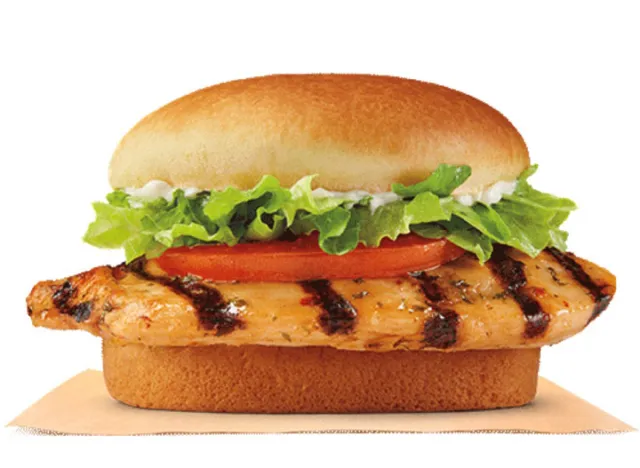
Calories: 410
Fat: 15 g (Saturated fat: 3 g)
Sodium: 940 mg
Carbs: 43 g (Fiber: 2 g, Sugar: 7 g)
Protein: 35 g
A go-to in my book is always a grilled chicken sandwich, and when ordering at Burger King with health in mind, its Flame-Grilled Chicken Sandwich (currently only available in select states, such as Alabama) is a surefire win. With 35 grams of high-quality protein and only 3 grams of saturated fat, it's a welcomed addition to a balanced diet. Compared to other higher protein picks that log more than 30 grams of protein, like the traditional Whopper, you'll save nearly 9 grams of saturated fat and about 200 milligrams of sodium by opting for the poultry pick.
Big Fish (19 grams)
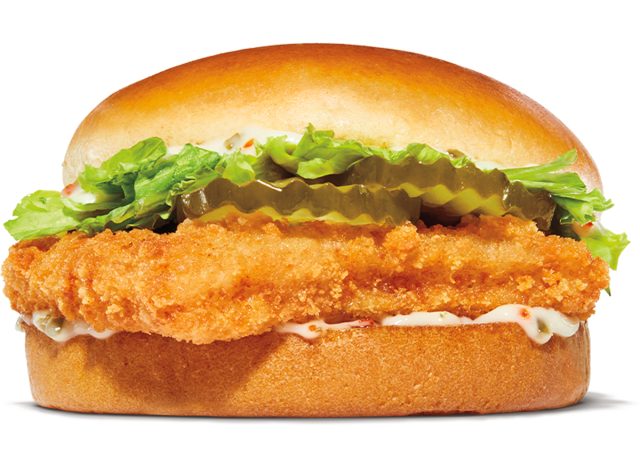
Calories: 570
Fat: 30 g (Saturated fat: 5 g)
Sodium: 1270 mg
Carbs: 58 g (Fiber: 3 g, Sugar: 8 g)
Protein: 19 g
The Food and Drug Administration recommends consuming seafood at least twice a week as part of a balanced diet to reap the omega-3 benefits this protein pick offers. And, while a grilled option is always preferred, when you're tight on time and looking to meet this recommendation, opting for the Burger King Big Fish sandwich is a welcomed alternative. According to the website Alaska Pollock, Burger King uses pollock fish in its Big Fish sandwich. Pollock is one of the best sources of lower mercury seafood, according to the FDA. But this sandwich is not a healthy option to include regularly as it's still deep-fried and packs a substantial amount of sodium, so choose this wisely and in moderation, making lower sodium choices the remainder of the day when you opt for this pick.
If you want to round off your meal with a sweet treat and the kids' applesauce won't cut it, consider the chocolate chip cookies and give the other to a friend (they come in a 2-pack). This will add just 160 calories to your meal, with 7.5 grams of total fat, 4 grams of saturated fat, 110 milligrams of sodium, 23 grams of carbohydrates, 1 gram of fiber, 14 grams of sugar, and only 2 grams of protein, but 100% satisfaction. The other treats listed (like the Classic Oreo Shake) contain around 86 grams of sugar while going well over the caloric value of what should be consumed in an entire main meal.
- Source: Leidy H. J. (2014). Increased dietary protein as a dietary strategy to prevent and/or treat obesity. Missouri medicine, 111(1), 54–58.
- Source: Carbone, J. W., & Pasiakos, S. M. (2019). Dietary Protein and Muscle Mass: Translating Science to Application and Health Benefit. Nutrients, 11(5), 1136. https://doi.org/10.3390/nu11051136
- Source: Leidy H. J. (2014). Increased dietary protein as a dietary strategy to prevent and/or treat obesity. Missouri medicine, 111(1), 54–58.
- Source: Clark, M. J., & Slavin, J. L. (2013). The effect of fiber on satiety and food intake: a systematic review. Journal of the American College of Nutrition, 32(3), 200–211. https://doi.org/10.1080/07315724.2013.791194









